 |
|

|
 |
TABLE of CONTENTS
|
Changing of commissioners: Zelle says farewell, welcomes Anderson Kelliher to MnDOT |
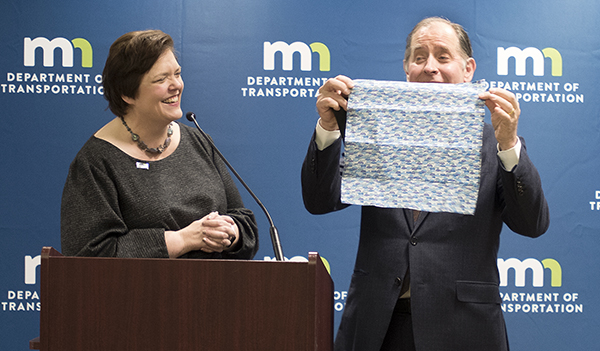
Marking the end of his six-year tenure as MnDOT commissioner Jan. 7, Charlie Zelle holds up a pocket square (patterned with cars) that incoming Commissioner Margaret Anderson Kelliher presented to him at an employee event in St. Paul. Zelle reciprocated by giving the new commissioner MnDOT's official lapel pin ("Wear it with pride," he said) as well as handing her "the key to the Commissioner Suite." Deputy Commissioner/Chief Engineer Sue Mulvihill emceed the event, which included remarks from Eric Davis, former MnDOT chief of staff, and Myron Frans, Minnesota Management & Budget commissioner.
Zelle said his experience as transportation commissioner has shown him that MnDOT "[employees] are completely committed to public service... It's not just a commitment to MnDOT, but to the worlds we affec... What an incredible responsibility, but what an incredible honor it is."
Anderson Kelliher said that, having grown up with two uncles who worked for MnDOT, she has "always had a sense of the family that is MnDOT, the team that is MnDOT... I'm so excited to build on your legacy, Charlie, and what you've done here."
A video of the remarks is available for viewing. Photo by Rich Kemp
(below) Zelle greets Mary Young (center) and Waubun Smith, both from the Office of Equity and Diversity, at his farewell event Jan. 7. Among his many responsibilities, Zelle was a member of Gov. Mark Dayton's Diversity & Inclusion Council and a strong proponent of MnDOT's efforts to attract and retain a diverse and inclusive workforce. Photo by Rich Kemp
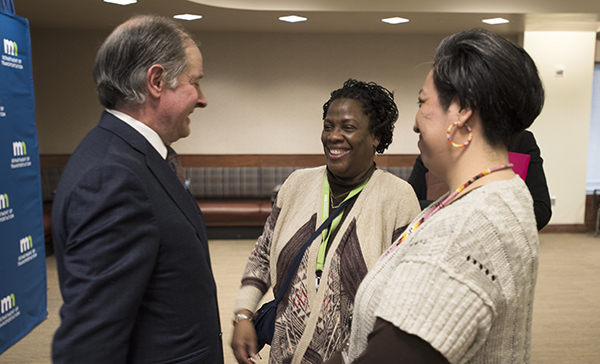
|
|
 |
|

|
 |
TABLE of CONTENTS
 |
MnDOT launches truck parking technology to help drivers find safe parking spaces |
By Sue Roe
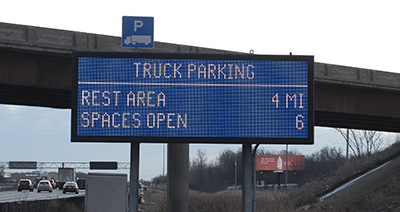
Dynamic message signs along I-94 and I-35 let truck drivers know how many parking spaces are available at the next rest area. Photo by Rich Kemp |
Minnesota is one of eight states participating in the country’s first multi-state truck parking information management system that launched Jan. 4 to help truck drivers find safe and legal parking. MnDOT installed the technology at six rest areas in the state. A seventh rest area will go online next spring.
The technology collects and broadcasts real-time information to dynamic message signs along the Interstate 35 and I-94 freight corridors to alert truck drivers about the number of available parking spaces ahead. Truckers and dispatchers can also access the information on the 511 traveler information system and smart phone applications. The 511 system will include a text and email notification feature that will be available in mid-January.
“This technology makes the regional freight corridor system safer and more efficient,” said Dan Rowe, state project manager. “Drivers can plan their routes better and make safer, smarter parking decisions.”
Truckers often spend an hour or more looking for safe parking. They end up parking in illegal and unsafe places such as ramps and shoulders.
“Hours of service limits force truckers to park in other areas than the rest areas, which fill up quickly,” said Rowe. “Well-rested drivers mean fewer fatigue-related crashes.”
Other benefits of the system include more efficient movement of goods, reduced fuel consumption and emissions and less non-routine maintenance repairs on highway shoulders and ramps.
The technology is available at the Lake Lakota, Big Spunk Lake, Enfield, Forest Lake and Elm Creek rest areas along the I-94 corridor and the Heath Creek rest area on the I-35 corridor. The St. Croix rest area on I-94 will be operational in the spring.
The system was funded with a $25 million federal TIGER grant in 2015. Minnesota received $1.2 million from the grant and contributed another $177,500. Other states in the region include Indiana, Iowa, Kansas, Kentucky, Michigan, Ohio and Wisconsin.
Project stakeholders include the Mid America Association of State Transportation Officials. More information is at www.trucksparkhere.com.

This billboard near Duluth on I-35 north of Hwy 95, tells truck drivers about available parking. Another billboard is located in Minneapolis on westbound I-94 near Snelling Avenue. Graphic courtesy of HNTB Corporation |
|
 |
|

|
 |
TABLE of CONTENTS
 |
2019 Minnesota state legislative session begins |
|
By Nick Carpenter, Government Affairs
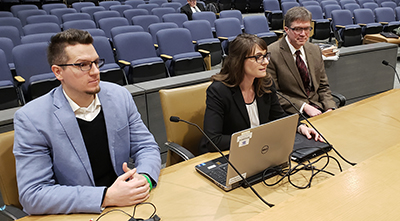
From left, Nick Carpenter, Government Affairs legislative mobility; Kristin White, Connected & Automated Vehicles innovation director; and Frank Douma, University of Minnesota state and local policy program director, prepare for a presentation at the Senate Transportation Finance and Policy Committee meeting Jan. 16. Photo by Erik Rudeen |
The 91st Minnesota state legislative session is officially underway as legislators from around the state converged on the capitol Tuesday, Jan. 8.
This session marks a time of transition with Gov. Tim Walz becoming the 41st governor of Minnesota, 39 newly elected state representatives receiving their oath of office and dozens of new appointments across various state agencies, including here at MnDOT.
Health care, education, economic development and equity top the list of priority topics this year. Transportation—funding in particular—will be an integral topic this session as well. MnDOT’s legislative proposals are currently being reviewed by Commissioner Margaret Anderson Kelliher and the Governor’s Office for consideration before they can be introduced as bills.
One topic that has already drawn interest this year centers on connected and automated vehicles.
Kristin White, Office of Connected & Automated Vehicles innovation director, provided an introduction of CAV to the Senate Transportation Finance and Policy Committee Jan. 16.
Twenty-nine states and the District of Columbia have enacted legislation related to CAV, including neighboring Wisconsin and North Dakota. Minnesota has yet to enact CAV-related legislation; however, former Gov. Mark Dayton issued a connected and automated vehicle executive order in March, 2018 that recognized CAV technology is evolving rapidly and Minnesota must prepare for the transformation and opportunities associated with it.
White also explained to the committee why CAV is important to the future of Minnesota. CAV technology can:
- Improve safety and move the state closer to achieving Toward Zero Deaths
- Encourage workforce and economic development
- Improve transportation equity and accessibility for all Minnesotans
- Promote environmental sustainability and public health
- Improve the efficiency of the transportation system for the movement of people, goods and services
CAV is expected to remain a hot topic this legislative session. Employees who would like to stay updated on transportation-related discussions and bills during this session can do so by visiting The Office of Government Affairs website on iHUB. Government Affairs will prepare and publish a legislative summary every week to the website during the session, which will conclude May 20. |
 |
|

|
 |
TABLE of CONTENTS
 |
Jeremy Greene eligible for vacation donation |
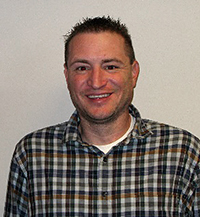
Jeremy Greene, Bridge Office, is eligible for the vacation donation program. Photo courtesey of the Bridge Office |
Jeremy Greene, Bridge Design Section, is eligible for the vacation donation program. Greene has worked in his current position for seven months.
Greene has been diagnosed with stage IV pancreatic cancer and will be receiving palliative chemotherapy treatments. His condition has caused him to use all of his sick and vacation accruals.
A GoFundMe page to help pay for Greene’s medical bills is part of a fundraiser page on the Employee Bulletin Board.
Also eligible for the vacation donation program are MnDOT employees Donna Koren, Operations Division; Tom Brown, transportation generalist in District 2; Donald Obernolte, Office of Environmental Stewardship; Kyle Goosman, District 8 transportation generalist senior; and Melissa Janzen, Office of Land Management.
To donate vacation hours, go to the Employee Self Service website and click “Other Payroll” and then “Leave Donations.” The site lists all state employees eligible for the program and allows employees to enroll as a recipient. |
 |
|

|
 |
TABLE of CONTENTS
 |
Brian Sorenson named new state traffic engineer |
|
By Rich Kemp

Brian Sorenson is MnDOTís state traffic engineer. Photo by Rich Kemp |
Brian Sorenson joined MnDOT as the state traffic engineer Jan. 3 and is located in the Waters Edge Building in Roseville.
Sorenson grew up in Hastings and graduated from South Dakota State University with a bachelor of science in civil engineering. He began his career with Scott County, where he worked for more than 11 years. He began working for Dakota County in 2006, and since 2010 has led the programming, transportation planning, traffic, design, right of way acquisition and project management areas of the transportation department as an assistant county engineer.
"In addition to his solid transportation experience, Brian is a strong leader and will be a great addition to our Traffic Engineering Office,” said Jody Martinson, assistant commissioner, Operations Division. “As we continue to grow and strengthen our relationships with our partners, I am excited to have Brian provide his local agency perspective to further enhance that important work."
The Office of Traffic Engineering establishes guidelines and procedures throughout the state, and builds relationships between state, county and city engineering staff to resolve questions about engineering and roadway safety. |
 |
|

|
 |
TABLE of CONTENTS
 |
Agency to tell its story in district, office business plans |
By Judy Jacobs, Office of Organizational Planning and Management
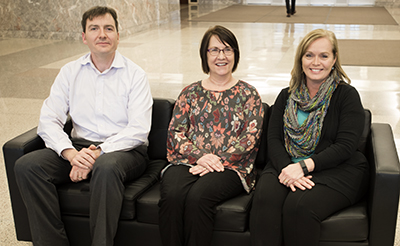
Members of the Office of Organizational Planning and Management will be conducting business plan training beginning next week. The four-person training team will work with nearly 40 MnDOT offices and districts across the state. The training team consists of Brian McLafferty, Judy Schmidt, Brenda Rivera and Gabe Perkins (not pictured). Photo by Rich Kemp |
MnDOT’s 5,000 employees do a lot of different things to deliver the transportation system, from high-profile services like program delivery and snow plowing to more behind-the-scenes processes like procurement and data governance. With so much going on across the department, describing what MnDOT does – and where it is going – can be a real challenge.
Business planning is one way in which MnDOT is getting better at telling its story. A business plan is a tool for communicating organizational goals and strategies for achieving for them. At MnDOT, business plans connect the goals and strategies in the Five-year Strategic Operating Plan to the core functions and projects of the districts and offices, enabling MnDOT to give very specific and tangible answers to the question: “How is MnDOT advancing its strategic priorities?”
“MnDOT is full of really smart, dedicated people who are committed to our mission and vision, and who are making decisions that align pretty well with what our plans say we should be doing,” said Sue Mulvihill, deputy commissioner and chief engineer. “We can do better at capturing that, especially at the front end when there is greatest opportunity for coordination. That’s what we are trying to do with business plans.”
MnDOT launched its current business planning program in 2017 with the development of district-and-office specific business plans for the current biennium. These business plans were developed in workshop settings by district and office management teams using a standard format and template that highlighted goals, risks, processes and measures.
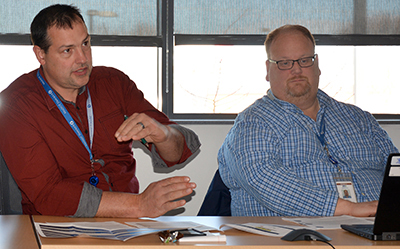
Mark Schoenfelder, District 6 engineer, and Gabe Perkins, District 6 training and development, who is on a mobility assignment with OPM, discuss district business plans during one of three business plan training pilot projects held in early November. Photo by Judy Jacobs |
Beginning Jan. 22, 2019 the Office of Organizational Planning and Management will start training districts and offices on the approach MnDOT is using to develop business plans for the next biennium, FY20-21. This approach features a number of improvements designed to make business planning more flexible, user-friendly and sustainable. Notable among the improvements is a shift from a static plan developed through facilitated exercise to an ongoing, dynamic process maintained within each district and office management team as part of their regular work.
“We heard you,” said Judy Schmidt, director, Office of Organizational Planning and Management. “Our office took the feedback you provided from the FY18-19 plans and have designed a consistent format in the form of an Excel spreadsheet that will serve as a living document each office and district can update as part of their process management. We want you to experience the value a strategically focused business plan can provide.”
To help prepare for the FY20-21 business plan rollout, OPM staff facilitated business planning pilot sessions with representatives from Districts 4 and 6 and the Office of Project Management and Technical Support.
“Our office was very excited to be involved in the pilot training,” said Tom Styrbicki, director, Office of Project Management and Technical Support. “We see business planning as a fundamental part of prioritizing our work efforts and aligning them with agency goals. Our business plan will serve as an ongoing framework for decision-making as our office and agency adapt to meet the challenges ahead of us.”
Current schedules call for each district and office to have a “live” version of its FY20-21 business plan on the business planning SharePoint site by the end of March, with the first division and agency level reporting of business plan results occurring this spring. As the process matures, business plan reporting is expected to play a key role in SOP implementation and the establishment of priorities for investment in MnDOT operations.
“The SOP is MnDOT’s plan, and we all have a role in implementing it,” said Mulvihill. “I am really looking forward to hearing what folks out in the districts and offices are seeing as their priorities for moving the SOP forward.”
For more information on MnDOT’s business planning, visit the OPM website.
|
 |
|

|
 |
TABLE of CONTENTS
 |
Holiday giving, MnDOT style |
By Mary McFarland Brooks

Retired Marine Steve Titus, Toys for Tots, accepts donations from Cindy Senger, District 3. The funds and toys were donated by employees in St. Cloud. Senger retired Jan. 2 after more than 40 years of state service. Photo courtesy of District 3 |
The holidays annually provide an opportunity for MnDOT employees to show their true colors by helping those in need, which sometimes includes our own employees. Each year, donations usually exceed the previous year's and 2018 proved to be one of the most successful for employee donations and the organizations and people they benefitted.
District 1
District 1 participated in the Toyland Express effort during the holidays and collected a total of 60 toys and $100 in cash.
District 2
Employees responded to the annual combined charities drive, spearheaded by Joe McKinnon, and employees donated $600 to the Christmas Giving Tree that includes ornaments hung in honor of district employees in need of extra support. The Giving Tree event raised a total of $2,000 from a potluck dinner, silent auction and employee donations. In the spirit of the holiday, District 2 also hosted a blood drive.
District 3, St. Cloud and Baxter
District 3/St. Cloud raised $2,424 and received 90 toys, including bikes from employees at a Toys for Tots holiday lunch fundraiser. The AFSCME union also donated $300 to Toys for Tots.
District 3/Baxter raised $1,080 and received several donated toys at a BBQ lunch and deer pong game fundraiser for Toys for Tots, leading up to the holidays. The AFSCME union again donated $300 towards Toys for Tots.
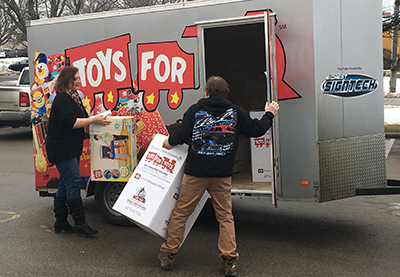
Marnie Krohse, District 6, helps load donated items with a Toys for Tots volunteer. Photo by Anne Meyer |
District 4
District 4 employees celebrated the season by hosting an annual potluck. This year $2,233 was raised to support the Red River Valley Hospice. District 4 employees have been supporting the hospice since 1995 and have donated more than $34,000 during that time.
District 6
MnDOT employees donated $486 dollars to Toys for Tots and filled two bins with toys at the Rochester location. Each year, Marnie Krohse organizes the campaign and works with volunteers from the Toys for Tots drive. Locally the Toys for Tots campaign helped 7,751 children in southeast Minnesota in 2017; a total for the 2018 campaign isn't yet available.

From left, District 8 employees Loretta Falk, business office, Sandra Schlagel, public affairs coordinator, and Laura Kanten, Human Resourses, present a donation from the Willmar Office to Tonia Danielson, KCFS staff. Photo courtesy of District 8 |
District 7
MnDOT employees partnered with the local State Patrol in their 11th year of collecting for the Toys for Tots program. The program distributes toys locally to more than 3,000 children in South Central Minnesota. Employees also are planning a food drive for late January.
District 8
Staff in the District 8/Willmar office provided food for local families facing difficulties this holiday season. Non-perishable food and personal care items, as well as cash donations, were collected for the Kandiyohi County Food Shelf. KCFS serves an average of 600 households monthly, operating entirely on donations and grants. On Dec. 21, 100 pounds of food and care items, plus $140 were delivered to the food shelf. Due to a purchasing agreement with Second Harvest Heartland, the cash donation will allow KCFS to purchase $1,400 worth of food.
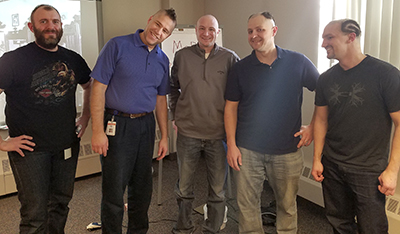
Jeremy Greene (center) poses with (from left) Brandon Day, Ed Lutgen, Ben Jilk and Braden Cyr. The Bridge Office employees display their new head space after raising funds to shave their heads to contribute to Greene's health care costs. Photo by Melissa Schultz |
MnDOT Bridge Office
At the Bridge Office’s annual New Year’s party, several coworkers raised money by shaving their heads to benefit co-worker Jeremy Greene, who lost his hair due to chemotherapy. Greene is a recently hired architectural drafter, who was diagnosed with pancreatic cancer and is currently ineligible for health care. Committed to helping Greene’s situation, co-workers, agreed to have interesting patterns shaved into their hair if a goal of $2000 was raised. In all, $3,832 was raised from head shaving, a silent auction and photographs. It was provided to Greene for ongoing medical expenses. Watch the KARE 11 broadcast about MnDOT employee’s ongoing efforts to support Greene.
Office of Environmental Stewardship
The Office of Environmental Stewardship conducted a winter clothing drive of new and gently used winter clothing for Prism, www.prismmpls.org, an organization that provides clothing, housing stability and food to children, adults and seniors in the NW suburbs.
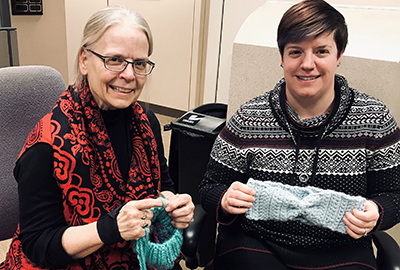
Bobbie Iverson, Office of Project Management and Technical Support, and Renee Barnes, Office of Environmental Stewardship, hand knit items that they donated to Prism. Photo by Mary McFarland Brooks |
During the holiday season, more than 20 bags, filled with new and gently used clothing, were collected for Prism. The MnDOT lobby tree collected more than 100 scarves, hats and mittens from MnDOT employees that were also donated to Prism. To provide that personal touch, Renee Barnes and Bobby Iverson knitted hats and headbands to add to the Prism clothing drive.
"Once again our MnDOT community has stepped up for those in need," said Teresa Martin, cultural resource archeologist. “Prism was very thankful for the clothing donations and especially delighted to receive hand-knitted items.”
Capitol United Cycling Club
In early September more than 25 members and friends of the Capitol United Cycle Club successfully completed the third Annual Bob Prudhomme Memorial Ride. Participants in the charity ride contributed a total of $1,750 for bikes and helmets that were purchased and donated to Toys for Tots.
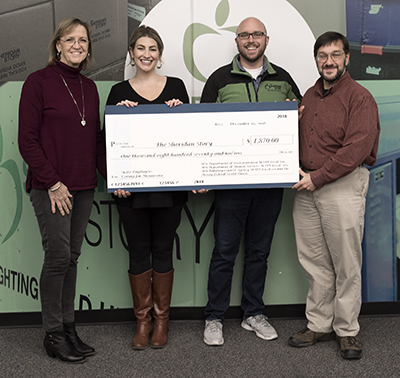
Cheryl Hunstock (left), Office of Land Management, and Mark Snyder (right), Pollution Control Agency, present a check from MAPE locals to Liz Tenpas, Sheridan Story, director of development, and Rob Williams, Sheridan Story, founder and executive director. The funds were donated by employees at CO and other state agencies. Photo by Rich Kemp |
“Thanks to everyone who participated and for continuing Bob Prudhomme’s cycling legacy,” said Tim Henkel, assistant commissioner, Modal Planning and Program Management. “It’s rewarding, not only to be able to ride with this group of active cyclists, but to be able to donate bikes and helmets for kids to enjoy riding as well.”
MnDOT and MAPE locals
MnDOT and MAPE Local 801 collected monetary contributions for The Sheridan Story, www.thesheridanstory.org, whose mission is to provide food to students during weekends, school breaks and summer months. The combined contributions from MnDOT, the Pollution Control Agency, the Department of Human Services and Hiway Federal Credit Union provided more than $1,900 to The Sheridan Story.
“The support from MnDOT employees and MAPE is a great demonstration of how we can all work together to solve big problems in our community, like child hunger,” said Rob Williams, founder of The Sheridan Story. “This donation will help provide eight children in our community with a weekend's supply of food for a whole school year. Thank you!” |
 |
|

|
 |
TABLE of CONTENTS
 |
Why Should MnDOT Employees Enroll in LDP? |
By Carol Hennekens, Workforce Development
The deadline is fast approaching for enrollment in the Leadership Development Program. The deadline to enroll in Group 12 LDP is this Friday, Jan. 18. If you are still deciding whether to enroll or approve an employees’ enrollment, take a look at the impact this program has had on individuals, teams and MnDOT. This information is taken from the impact surveys conducted with employees and supervisors after their participation in past LDP groups. The information is summarized for this article. The comments received are taken from the survey results and are anonymous.

|
Employees have stated that they have improved and applied what they have learned in LDP to their work. The top improved competencies include: higher confidence and motivation, better communication with team members and customers, increased responsibility and ownership, better time management skills, and more overall knowledge about MnDOT.
“Delegation, stress/conflict management and recognizing individual strengths (vs. weaknesses) have become much easier for me – as a result of my participation in the LDP. My construction projects have run much more smoothly as a result!”
Supervisors have commented on the increased collaboration in their teams, increased production, higher engagement and better service to customers.
“More confident in his ability to lead, teach, train and motivate other team members.”
“I have noticed conflicts are resolved much faster and employees involved are satisfied with the outcome more often. Work is done more promptly and to a higher degree of accuracy.”
Overall, the benefits to MnDOT can be summarized into themes which include:
- Increased confidence and awareness
- Stronger communication abilities
- Specific task application and increased efficiency
- Application of learned organizational knowledge
- Establishment or improvement of relationships
You might be thinking that training takes time away from everyday work. Well, it does, but consider this: A well trained employee saves the individual, team and MnDOT time and money over the long run. If your employee can be more effective and efficient as a result of participating in the program, it is well worth it in the long run.
The LDP is offered to all employees; managers and supervisors as well. It is a cost effective way to brush up on individual skills and competencies. The uniqueness of the program allows participants to create their own goals and work on them at their own pace.
The LDP Team looks forward to receiving your enrollment and meeting you at orientation. Contact the LDP team with questions: Carol Hennekens, Shawn Meade or Barbara Vang. |
 |
|
| |
|



